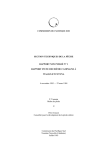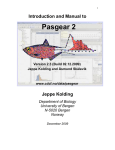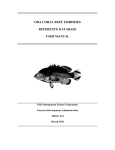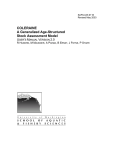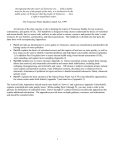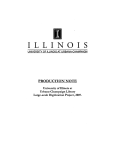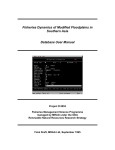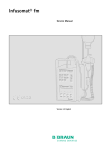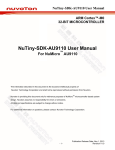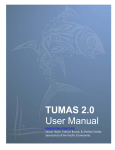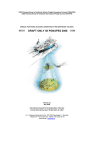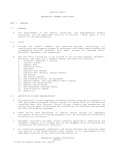Download Software for estimating potential yield under uncertainty
Transcript
Software for estimating potential yield under uncertainty Final Technical Report March 2001 Final Report - Administrative Details DATE COMPLETED: Day\Month\Year: 30/1/2001 TITLE OF PROJECT R 7041: Software for estimating potential yield under uncertainty PROGRAMME MANAGER / INSTITUTION Professor John Beddington MRAG Ltd 47 Princes Gate, London SW7 2QA FROM 1/ 01/96 REPORTING PERIOD AUTHORS OF THIS REPORT MRAG TO 31/3/00 Dr G. P. Kirkwood R 7041 Yield software – Final Technical Report i Acknowledgements This project was funded through the UK Department for International Development (DfID) Fisheries Management Science Programme (FMSP), which is managed by MRAG Ltd. The project leader (Dr G Kirkwood) gratefully acknowledges the help of Trevor Branch in specifying the software and the programming skills of Trevor Branch, Simon Nicholson and Steve Zara during the writing and testing phases. MRAG R 7041 Yield software – Final Technical Report ii Table of Contents Final Report - Administrative Details ................................................................i Acknowledgements .......................................................................................... ii Table of Contents............................................................................................ iii Final Technical Report .................................................................................... 1 1. Executive Summary ............................................................................... 1 2. Background ............................................................................................ 1 3. Project Purpose...................................................................................... 4 4. Research Activities................................................................................. 4 5. Outputs................................................................................................... 5 5.1 Example analysis ............................................................................. 5 5.1.1 Parameters for L. mahensa. ....................................................... 5 5.1.2 Yield-per-recruit analyses........................................................... 9 5.1.3 Equilibrium yield analyses ........................................................ 12 5.1.4 Transient analyses ................................................................... 17 5.1.5 Summary .................................................................................. 19 6. Contribution of outputs ......................................................................... 20 7. References........................................................................................... 20 MRAG R 7041 Yield software – Final Technical Report iii Final Technical Report 1. Executive Summary The FAO guidelines on the precautionary approach to management of capture fisheries and the texts of several new international fishery management agreements indicate the importance of precautionary reference points in the framing of fishery management advice. The guidelines also emphasise the need to take proper account of uncertainty in this advice. Following this advice poses a serious problem for fishery officers and scientists in developing countries, since the calculations involved require a greater degree of analytical and programming sophistication than is often available, and existing software packages commonly used by them do not allow for such calculations. The Yield software package developed during this project was aimed to fill this gap. Written in Visual Basic, the software has a standard Windows user interface and a very extensive on-line help system. It also incorporates a comprehensive example analysis of data from an Indian Ocean snapper fishery. Users are able to specify levels of uncertainty in each of the input parameters in terms of three possible probability distributions, and they can also specify the level of inter-annual variability in annual recruitment. For each of the calculations available in the software, results are presented in terms of frequency distributions for the quantity concerned, rather than a single value as is usual, thus allowing the full extent of uncertainty to be determined. Stochastic forward projections also taking account of parameter uncertainty allow the user to explore further the likely result of different management options. The improved scientific advice will considerably enhance the likelihood of sustainable management of vital fishery resources, which in developing countries often represent major sources of animal protein, employment and income. 2. Background For many years, the explicit or implicit primary management goal for most commercially exploited fisheries was to take the maximum sustainable yield (MSY). One of the advantages of this was that, provided time series of annual catches and catches per unit effort (CPUE) were available, estimates of this quantity could be calculated by fitting simple stock production models. With software packages such as CEDA (MRAG, 1992a), obtaining such estimates and corresponding indications of the uncertainties associated with those estimates was within the reach of fishery officers in developing countries. In many fisheries, it is also possible to obtain estimates of von Bertalanffy growth curves (e.g. using the LFDA software, MRAG 1992b). Provided an estimate is also available for the natural mortality rate, then simple yield-per-recruit calculations can also be carried out, using the software package FISAT (1997), for example. This then enables estimation of curves relating the yield-per-recruit to the fishing mortality rate, F, and from that calculation of the fishing mortality rate that produces the maximum yield-per-recruit (FMSY). In the absence of estimates of the MSY, FMSY has at times been used as a target fishing mortality rate, but as this often very large (indeed it is often infinite) and alternative target, F0.1, introduced by Dr John Gulland, is often used in its place. F0.1 is defined as the value of F such that the slope of the yield-per-recruit curve is 0.1 times the slope of that curve at the origin. This apparently arbitrary definition always produces a value of F that is less that the F at maximum yield-per-recruit FMaxYPR, and it is commonly of a similar size to FMSY. It is, however, significantly harder to calculate. MRAG R 7041 Yield software – Final Technical Report 1 The final calculation that was commonly done is earlier stock assessments was that of curves relating the spawning stock biomass (SSB) per recruit to the fishing mortality rate. These curves illustrate that as F increases, the SSB-per-recruit decreases. For high values of F (e.g. often for FMSY), the SSB-per-recruit is often only a very small fraction of its unexploited level. Assuming that the numbers of recruits remain (on average) constant regardless of the size of the SSB is a non-conservative one at best, but it is particularly dangerous for very low SSBs. Following Beddington and Cooke (1983), if the SSB-per-recruit is less than 20% of its unexploited level, it has commonly been taken as a rule of thumb that there is a non-ignorable risk that future recruitment may be reduced. Adopting a terminology that has now become common, these various values of F that have often been calculated in stock assessments can be called reference points. The first three mentioned above, (FMSY, FmaxYPR and F0.1) are known as target reference points, in that they represent potential target values to aim for in setting appropriate levels of fishing mortality. The last reference point, the F that produces a 20% SSB-per-recruit relative to its unexploited level, is rather different. It has come to be known as a limit reference point, in that it is not a target at all; rather it is a level of F that should not be exceeded. A typical illustration of these reference points is in the figure below, which plots the equilibrium yield per 1000 recruits, the equilibrium yield (taking a non-constant stock recruitment relationship into account) and the SSB-per-recruit as functions of the fishing mortality rate. EQUILIBRIUM YIELDS WITH AND WITHOUT SRR 90.0 80.0 20000.0 YIELD 70.0 60.0 15000.0 50.0 10000.0 40.0 30.0 20.0 5000.0 10.0 0.0 0.00 0.20 0.40 0.60 0.80 SSB-per-recruit (% unexploited) 100.0 25000.0 0.0 1.00 FISHING MORTALITY RATE F YIELD PER 1000 RECTS YIELD WITH SRR F0.1 SSB-per-recruit In this figure, the yield-per-recruit rises with increasing F until it reaches a maximum at around F=0.8. At this value of F, the SSB-per-recruit has fallen to around 10% of its unexploited level, well below the 20% rule of thumb. When a stock-recruitment relationship (SRR) is taken into account (but one that still produces 1000 recruits in its unexploited state), we see that the recruitment has definitely fallen well before F reaches this level; indeed the MRAG R 7041 Yield software – Final Technical Report 2 equilibrium yield is now only at 25% of its real maximum (at F=0.2). In contrast, for the parameters used to calculate this figure, the value of F0.1 is 0.26, only marginally above the true FMSY, with a corresponding SSB-per-recruit of around 35% of its unexploited level. One final point to note about the calculation of reference points described above is that they assume the population is in deterministic equilibrium. In particular, this means that they assume that there is no stochastic variability in annual recruitment. Perhaps the one thing that is common to fish stocks is that all appear to demonstrate considerable interannual variability in recruitment; see for example Myers et al (1995). This is an issue also addressed by Beddington and Cooke (1983), who found, in particular, that stochastic variation in recruitment can, with high probability, reduce the SSB below a fixed level even though deterministic calculations show that the equilibrium SSB will be above that value. By the early 1990s, particularly following the UNCED Rio declaration, it had become clear that to avoid yet more stocks moving into the overexploited category, it was necessary to adopt a more precautionary approach to fishery management. One outcome of this realisation was a set of guidelines for a precautionary approach to capture fisheries (FAO, 1995) that emphasised, inter alia, of calculating and using both target and limit reference points, and of taking full account of uncertainties and associated risks. The FAO Code of Conduct for Responsible Fisheries, which soon followed the publication of the guidelines, also incorporated these sentiments. Perhaps the most recent and most clearly expressed exposition of these ideas is contained in Annex II to the Draft Agreement for the Implementation of the Provisions of the United Nations Convention on the Law of the Sea of 10 December 1982 Relating to the Conservation and Management of Straddling Fish Stocks and Highly Migratory Fish Stocks. This is reproduced below. GUIDELINES FOR APPLICATION OF PRECAUTIONARY REFERENCE POINTS IN CONSERVATION AND MANAGEMENT OF STRADDLING FISH STOCKS AND HIGHLY MIGRATORY FISH STOCKS. 1. A precautionary reference point is an estimated value derived through an agreed scientific procedure, which corresponds to the state of the resource and of the fishery, and which can be used as a guide for fisheries management 2. Two types of precautionary reference points should be used: conservation, or limit, reference points and management, or target, reference points. Limit reference points set boundaries which are intended to constrain harvesting within safe biological limits within which the stocks can produce maximum sustainable yield. Target reference points are intended to meet management objectives. 3. Precautionary reference points should be stock-specific to account, inter alia, for the reproductive capacity, the resilience of each stock and the characteristics of fisheries exploiting the stock, as well as other sources of mortality and major sources of uncertainty. 4. Management strategies shall seek to maintain or restore populations of harvested stocks, and where necessary associated or dependent species, at levels consistent with previously agreed precautionary reference points. Such reference points shall be used to trigger pre-agreed conservation and management action. Management strategies shall include measures which can be implemented when precautionary reference points are approached. 5. Fishery management strategies shall ensure that the risk of exceeding limit reference points is very low. If a stock falls below a limit reference point MRAG R 7041 Yield software – Final Technical Report 3 or is at risk of falling below such a reference point, conservation and management action should be initiated to facilitate stock recovery. Fishery management strategies shall ensure that target reference points are not exceeded on average. 6. When information for determining reference points for a fishery is poor or absent, provisional reference points shall be set. Provisional reference points may be established by analogy to similar and better-known stocks. In such situations, the fishery shall be subject to enhanced monitoring so as to enable revision of provisional reference points as improved information becomes available. 7. The fishing mortality rate which generates maximum sustainable yield should be regarded as a minimum standard for limit reference points. For stocks which are not over-fished, fishery management strategies shall ensure that fishing mortality does not exceed that which corresponds to maximum sustainable yield, and that the biomass does not fall below a pre-defined threshold. For over-fished stocks, the biomass which would produce maximum sustainable yield can serve as a rebuilding target. These requirements are all exemplary and the calculation of the various quantities involved is well within the scope of large fisheries departments in developed countries. But such calculations represent a really daunting task for many developing country fisheries officers. The aim of the Yield software package developed under this project is to allow them to make these calculations with ease, even in circumstances where knowledge of some of the biological parameters required is poor and there may be strong stochastic variability in recruitment. 3. Project Purpose To develop and disseminate a user-friendly, windows-based, software package for estimating potential yields, which properly takes into account uncertainty in biological parameter estimates and inter-annual variability in recruitment. Users will be able to estimate yields that are compatible with differing management objectives. Comprehensive tutorials and manuals will accompany the software. 4. Research Activities The research activities consisted of specifying the software, programming it in object-oriented Visual Basic, testing, incorporation of a comprehensive on-line help system and including a detailed expository example analysis of data for an Indian Ocean snapper and emperor fishery. The final version was sent to two expert external reviewers, and then revised in light of their comments. The software will be disseminated through the new FMSP web site. MRAG R 7041 Yield software – Final Technical Report 4 5. Outputs 5.1 Example analysis We present here an example analysis of yields and yield reference points using data for Lethrinus mahensa, one of the main species taken in fisheries for snappers and emperors in the western central Indian Ocean, on banks around the Chagos Archipelago, the Seychelles, and Mauritius. The aim is to illustrate how to collate and enter appropriate information on the biological and fishery parameters and their uncertainties, and how to interpret the results from the various analyses carried out using the software. In order to avoid duplication and to keep this example analysis down to a reasonable length, we omit details on the mechanics of using the software. Instead, links are given at appropriate places to relevant sections of the Help files, where comprehensive information on these aspects may be found. For users unfamiliar with the types of analyses carried out in this software package, we suggest that you first simply read through the example analysis, diverting to appropriate sections of the help files for more information as needed. Having done so, we then suggest that you attempt to repeat the analyses, as suggested in the text. Before doing so, however, we strongly suggest that you print out this section of the help files, as you will find that switching back and forth between analysis and the help files is tedious at best. 5.1.1 Parameters for L. mahensa. A data file containing estimates of parameters and their uncertainties for L. mahensa, LmahDat.txt, has been distributed along with the software. After starting the Yield software, load this parameter file (see Load parameters). The name of the species and the data file should then appear in the header of the main form. Biological and fishery parameters contained in the loaded data file may be inspected (and changed or entered; see Entering parameters) using the Parameters menu. The first item on that menu is Von Bertalanffy… , which allows the von Bertalanffy growth parameters and their uncertainties specified in the parameter file to be inspected (see Entering von Bertalanffy parameters). Selecting this menu item will reveal that uncertainties have been specified for L∞ and K, but not for t0. Delving further, you will find (see Choose distribution for uncertainty in Linfinity) that L∞ has been specified to have a normal distribution with mean = 53.6 and CV = 0.08; K has a lognormal distribution with mean = 0.128 and CV = 0.17; and t0 has a value fixed at 0. Where did these values come from? The best potential source of information for these and all the other parameters obviously is data collected directly for the species and from the fishery itself. This is the source used for the L. mahensa parameters. For the growth parameters, both length frequency distributions and age-length data were collected for each of the main fisheries in the western central Indian Ocean during a UK Department for International Development (DFID) funded project carried out by MRAG Ltd. The results were described in Pilling et al (1999) and in a PhD thesis by Dr G. Pilling (1999). For L. mahensa, the length frequency data were analysed using the Elefan method as implemented in the LFDA software (MRAG, 1992), and estimates of von Bertalanffy parameters were obtained by non-linear regression analysis of the age-length data. The means and CVs quoted are the means and CVs of the sets of estimates obtained (there were 12 in all). As for the distributions, there is an element of arbitrariness in their selection. With just 12 individual estimates, it is rather difficult to identify an appropriate distribution with any degree of certainty. The distribution of estimates of L∞ was roughly symmetrical; hence the choice of the normal distribution. The distribution of estimates of K was also reasonably symmetrical, but there was a hint of a slightly longer tail towards higher values of K. More importantly, however, it is known that K must be greater than zero. Negative values can be avoided by MRAG R 7041 Yield software – Final Technical Report 5 using a lognormal distribution, which in any case can also be reasonably close to symmetrical; see the plot of the selected distribution for K. Users with experience in estimating growth parameters may be rather suspicious of the relatively low levels of variability in L∞ and K, and even more so of the apparently certain and suspiciously round value of t0. They have every right to be. It is usually impossible when analysing the types of length frequency data available using the Elefan method to obtain any estimates of t0. However, such is not the case when estimating growth parameters using age-length data. In practice, the age-length data available contained very few observations for small ages and lengths. The implication of this is that it is actually very difficult to estimate all three von Bertalanffy parameters with any precision at all: the data were compatible with quite large negative values of t0 (which went with low K and high L∞ values) or small values of t0 (which went with high K and low L∞ values). The estimates used here in the end were those corresponding to t0 = 0. Taking this approach almost certainly underestimates the true uncertainties in growth parameters, but it suffices for this example. A final, rather technical point should also be made here. Even ignoring the parameter t0, it is almost universally observed that when estimates of L∞ and K are being calculated, either using individual data sets or combining sets of estimates from different data sets, there tends to be a high negative correlation between the two. In the L. mahensa case, the correlation is as high as –0.89. When originally specifying the software, we were well aware of this issue, but given the almost complete lack of cited estimates of the correlation between L∞ and K in the literature, we decided to ignore it. In retrospect, this may not have been the right decision, and later versions of the software will allow the user at least to enter a value for the correlation between L∞ and K. The current version assumes that the two parameters are independent. (Note that in Dr Pilling’s final analyses, account was taken both of individual variability in growth parameters and of estimated correlations between all three growth parameters, but this requires methods far beyond the scope of this software package). How might users collate the information needed to specify means and CVs for von Bertalanffy parameters? If they are lucky, data will be available (or can be collected) from their fishery to allow direct estimation of mean values at least. Note, however, that no reliable estimates of growth parameter uncertainty are available from any currently-used method for analysing length frequency data, so there still remains a problem there. Fortunately, even if no direct estimates are available for your species and fishery, the excellent and comprehensive database FishBase 98 almost certainly will have recorded estimates of biological parameters for the species concerned or a closely related species. This should allow at least a rough idea to be gained as to appropriate mean values and likely ranges of values of the von Bertalanffy growth parameters. Be warned, however, that some judgement still needs to be used when using data from related species. For example, even if attention is restricted to lethrinid species, recorded pairs of estimates of L∞ and K range from (16.2, 0.86) for L. genivittatus in New Caledonia to (106, 0.061) for L. olivaceus in the Yemen. Given the L. mahensa data, neither are at all likely for this species. Turing to length-weight parameters (see Entering Length-weight parameters), you will see that only single values have been entered in the L. mahensa data set. Length-weight data are perhaps the easiest biological data of all to collect and analyse, and in most cases they show relatively low levels of variability. That was certainly the case with the L. mahensa data, and we have opted not to specify uncertainties around the entered values. If length-weight parameters are the easiest to estimate, the next parameter, the natural mortality rate, is almost certainly close to the hardest. Fortunately, the empirical relationship developed by Pauly (1980) and FishBase 98 come to our rescue again. Two options are available after selecting the Natural mortality… item from the Parameters menu: the user can enter a single value (or distribution) for the natural mortality rate, or use Pauly’s (1980) empirical relationship (see Enter natural mortality rate, Enter parameters for Pauly’s equation). For L. mahensa, we also had no reliable direct estimate of the natural mortality rate available, so for this example we have opted to use Pauly’s relationship. The temperature entered (27°C) was extracted from the Nautical Almanac for the Indian Ocean. No uncertainty has been specified about this temperature. MRAG R 7041 Yield software – Final Technical Report 6 While estimates of the natural mortality rate are available from FishBase 98 for at least some species, many of these have been calculated using Pauly’s equation. Unless you have available an estimate or estimates of the natural mortality rate that you consider to be quite reliable, we would suggest in most cases that you use the Pauly’s equation option, and certainly that you use this option rather than enter a single value that itself was calculated using this relationship. The reason is that, if you use the Enter parameters for Pauly’s equation option directly, then the uncertainties you entered for the von Bertalanffy parameters will automatically be taken into account in the simulations, and they will by themselves induce uncertainties in the value of the natural mortality rate. The next parameters to be entered are the maturity and capture parameters (see Maturity and Capture). For L. mahensa, we have opted to enter lengths, rather than ages, and we anticipate that this choice will be made most times when the software is used (if for no other reason that ages are often so hard to estimate directly). Based on data collected from the fisheries, the (knife-edge) length at maturity has been set to have a lognormal distribution with mean = 27.6 cm and CV = 0.05. The mean and CV were estimated from data on the lengths at which 50% of the fish first attained maturity, and the lognormal distribution was used because the ogive of proportions mature at length was rather steeper at low lengths than at higher lengths, suggesting that the distribution of length at 50% maturity had a slightly longer tail towards higher lengths. The length at first capture was set at a constant value of 22.8 cm. This, of course, is one of the parameters that can, in principle, be changed by management regulation (e.g. by setting minimum landing sizes, or mesh sizes). The actual mean lengths at first capture differ amongst the different fisheries in the western central Indian Ocean, however here seems little point in reflecting this in the uncertainties in this parameter. However, if the mean length at first capture tended to differ substantially between years in an individual fishery, then it would be entirely appropriate to specify uncertainties about this parameter. The next items to specify are the seasons (see Spawning and Fishing seasons). Three things need to be set. The first is the time step interval. Here, we have set this as Monthly. This is not strictly necessary in order to specify the spawning and fishing seasons, which have been taken to occur all year round based on available information. However, using a yearly time step is likely to lead to inaccuracies in the numerical calculations for a species that only lives for a maximum of 15 – 20 years, so Months is the appropriate time step. The last set of parameters to enter are those for the stock-recruitment relationship (see Choose type of stock recruit relationship). This is even harder that setting the natural mortality rate, and at least one of the values entered here is, to be honest, partly a guess. It may seem rather odd to admit this in what is a demonstration of the use of the software, but in many cases, it is likely that this will also be the situation facing the typical user, especially those in developing countries with relatively little information available about their fishery. It therefore seems appropriate to attempt to demonstrate what can be done in such cases. The first choice to be made is of the form of stock-recruit relationship. That is relatively easy. The only two real possibilities in the current context are Beverton and Holt, or Ricker. The Ricker relationship, most commonly seen in the context of salmon stocks, is generally thought to apply in circumstances where there is either very substantial cannibalism or where there are restricted spawning areas. Neither is thought to apply to L. mahensa, so a Beverton and Holt relationship seems the most appropriate, as it is likely to be in most cases. With regard to the parameters (see Beverton and Holt SRR- Standard formulation, Beverton and Holt SRR- Steepness formulation), whichever is chosen, there are essentially two to specify. One of these is the so-called steepness parameter. There is some external information available on typical values of this parameter. This comes from the data originally collated by Myers et al (1995), now included in FishBase 98. Based on values included in this database for related species, Mees and Rousseau (1997) identified a lower limit for a related parameter that was equivalent to a steepness parameter of 0.8. On those grounds, we have chosen to assume that the steepness parameter is uniformly distributed between 0.8 and 0.95. MRAG R 7041 Yield software – Final Technical Report 7 The second parameter is the maximum (or unexploited) number of recruits (or SSB). This parameter is, of course, entirely stock-specific. Small stocks will have a small maximum number of recruits; large stocks will have a large number. What that number is will be a function of the fecundity of the stock, the productivity of the waters in which it spawns, the size of the available spawning or nursery areas, and so on. Regrettably, such information cannot be gleaned from estimates obtained from related species, or the same species in different areas. If you are very fortunate, then an abundance survey may have been carried out prior to or shortly after the fishery was discovered. This may well provide estimates of the unexploited number of recruits or of the adult biomass. If so, then it is a relatively trivial matter to enter an appropriate value (with uncertainties) once the Use estimates of biomass or recruits option is selected. Alternatively, in other cases, estimates are sometimes available of biomass per unit area (perhaps between certain depth ranges in which the stock is found). Again, such information can in principle readily be used in conjunction with widelyavailable bathymetric information. Failing this, there is little else to fall back on, and an educated guess must be made. Fortunately, at least in terms of the reference points for the fishing mortality rate, this matters much less than might be imagined, as will be seen later. One possible approach is to choose a value for the unexploited number of recruits that produces a maximum sustainable yield that is of the same order of magnitude as catches, or preferably, other estimates of potential yields. For the shallow banks of the Chagos Archipelago, the potential yield for commercially important handline species may be approximated by comparison with yields observed in similar areas in the Indian Ocean. For example, Sanders (1988) assumed that the potential yield of the Chagos Bank would be equivalent to that observed on the more heavily exploited -2 Saya de Malha bank north of Mauritius (0.22 t km ). In the Seychelles, the sustainable yield -2 in shallow water strata was estimated to be 0.168 t km (Mees, 1992). However, catch rates in the Chagos Archipelago are less than in Seychelles or on the Saya de Malha bank. Thus, a -2 more conservative estimate of 0.100 t km may be more appropriate for the Chagos Archipelago. 2 The estimated area of the Chagos Archipelago less than 70m in depth is 8587 km . Using the above figures, estimates of the sustainable annual yield for the shallow sector of the Chagos Archipelago range from around 860 to 1,900 t (Mees et al., 1999). Using the mean values only for all other input parameters, some simple experimentation suggests that an unexploited number of recruits of 25 millions produces a mean MSY of 1430 t, which is roughly in the middle of this range. This value was therefore used for R0, but no uncertainty was allowed, to reflect the somewhat arbitrary nature of the value. The final parameter to enter on this form is the CV of inter-annual recruitment variability. In many cases, this will also be an elusive parameter. For L. mahensa, age frequency data were available for a number of years, and it was therefore possible, using an assumed constant value for M, to project backwards and estimate numbers at age 0 in a number of years. The CV of these estimates was 0.25. Should such data not be available (as it most likely will not be for your fishery), then it should be possible to select at least a plausible value using the Meyers et al (1995) and FishBase 98 data. It may be sensible to try different analyses with different CVs (see later). The last information to enter serves essentially as documentation of the analysis: the fishery description (see Fishery description). For the example data file, you will see the species name and a brief description of the fisheries. Now that everything has been entered, it is time to see if they are all compatible and within sensible ranges. This is achieved using the Cross-check parameters menu item (see Cross-check parameters). Selecting this item, you should find that all parameters are consistent. So they should be, given that we set up the example parameter file! It is, however, worth following through the example in the help file for this menu item, in which the value of the natural mortality rate is deliberately changed to something silly, just to gain MRAG R 7041 Yield software – Final Technical Report 8 practice in seeing what to do if the parameters are found not to be consistent. But if you do so, don’t forget to change the natural mortality rate back to what it was originally before proceeding. If you had been entering a new data set, it would now be worthwhile saving the parameters (see Save parameters), though this is not necessary in this case. 5.1.2 Yield-per-recruit analyses The first analysis to carry out is of the equilibrium yield-per-recruit (see Equilibrium yield-perrecruit and related help files). Select Yield-per-recruit v F… from the Equilibrium menu. Accept the range of values of F over which the calculations will be performed (click OK). After a while, a series of plots will appear. Those illustrated below are displayed as fractions of unexploited biomass (see Calculate equilibrium yields and biomasses per recruit). This is frequently the most useful display option, as absolute values are not really important. Note that when you do these calculations, the results will not be identical to those illustrated in this example analysis. This is because you will have used different sets of random numbers (see Random seed). They should, however, not be too different! The top-left plot shows that the median yield-per-recruit, as a fraction of unexploited fishable biomass, reaches a maximum or close to one at values of F above about 1.3. Recall the mean value of M was around 0.39, so the F producing the median maximum yield per recruit is at least 3 times M, which is quite a high value. The upper 97.5% confidence band for relative yield-per-recruit is still rising as F reaches 2.0, while the lower 2.5% confidence band may have reached a maximum for F somewhere over 1.1. Yield-per-recruit plots that suggest the maximum occurs at high values of F are very common. Whether or not this occurs is largely determined by the relative values of M and K, and even more so by the relative values of the length at first capture and length at maturity. This should not be taken to suggest that the stock can withstand almost any level of fishing mortality, as the remaining plots show. The other plots show the relationship between various biomasses-per-recruit, as a fraction of their unexploited level, and F. Here, we shall only comment on the relative SSB-per-recruit. Whether one looks at the median, or at either confidence band, it is clear that levels of F that MRAG R 7041 Yield software – Final Technical Report 9 produce yields-per-recruit at or near the maximum will also reduce the SSB to levels that are a tiny fraction of its unexploited level. Remember that yield-per-recruit analyses explicitly assume that recruitment is unaffected regardless of how low the SSB falls. This is extremely unlikely when the SSB is reduced to levels seen in the plot for high values of F. Before moving on, if you wish to keep a record of your analyses, you may wish to print out a copy of this form. Also, if you want to see the results in more detail, you can do so clicking the Medians and intervals button. The next step in the analysis is to calculate yield and biomass per recruit reference points (see What are reference points?, Calculate equilibrium yield-per-recruit reference points). Select Yield-per-recruit reference points… from the Equilibrium menu. You will see three reference points have been checked for calculation (Maximum yield-per-recruit, F0.1 and the target SSB/Initial = 0.2). Click OK to accept these and in time a results form similar to the one below will appear. The first to be illustrated is that for maximum yield-per-recruit. Again, the display option chosen is as a fraction of unexploited biomass. For more details, see Equilibrium yield-per-recruit reference points: Interpreting the results. This form displays 6 histograms. The top left one is of the fishing mortality rate that produces the maximum yield-per-recruit. The way in which these results are calculated is explained in detail in the Simulating under uncertainty section of the Help files. For the purposes of explanation here, we simply note that 100 simulations were carried out (you can check this by selecting Number of simulations in the Options menu, but don’t do so right now, as the results form will then disappear and it will have to be produced again). The numbers appearing on the x-axis of the histogram correspond to the mid-points of each histogram bin. Thus the first bin, labelled 0.9, in this case refers to values of F in the range 0.6 – 1.6, the second to 1.6 – 2.6, and so on. The largest frequency (for F in the range 1.6 – 2.6) has around 30 observations. Note the occurrence of 28 cases of “infinite”F. Quotes are used here because any F greater than around 20 times the mean value of M used (0.392) is treated as being effectively infinite. MRAG R 7041 Yield software – Final Technical Report 10 Over 50% of the time, the F producing the maximum yield-per-recruit exceeded 2.4. This confirms the impression given by the yield-per-recruit plots discussed above. The SSB-per-recruit histogram also confirms the impression given by the earlier plots: the largest of all the values of SSB-per-recruit was less than 11% of its unexploited value. Note that, while the first bin (labelled 0) of this histogram nominally refers to values in the range – 0.0065 to 0.0065, since negative values of SSB-per-recruit are impossible, it actually refers to the range 0 to 0.0065. Defining algorithms for automatic labelling of histograms is difficult, and we have not always got it absolutely right. This is why the user is offered the option of producing a table of results, which can be transferred to your favourite graphics package to produce final publication-quality plots. Clearly, the maximum yield-per-recruit reference point is not one that can safely be used as a management target for this species. The next reference point to examine is the F0.1 reference point. Selecting results for F0.1 produces the following form (again using the Fraction of unexploited biomass display option). As explained in the What are F0.x reference points? Help item, the F0.1 yield-per-recruit reference point has a rather odd definition, but it has proved rather useful in practice, especially in circumstances, such as the ones seen here, when the maximum-yield-per-recruit reference point is obviously not particularly useful. The most frequently occurring value of F0.1 lies in the range 0.37 – 0.39, and the maximum in the range 0.57 – 0.61. Compared with the mean M (0.392), these are obviously more sensible values of F. Also, in the majority of cases, the SSB-per-recruit corresponding to F0.1 exceeds 20% of its unexploited level, a proportion often treated as one below which one would prefer not to fall. MRAG R 7041 Yield software – Final Technical Report 11 We will need the median and confidence limits for the estimated F0.1 later. Clicking on the Results button will produce a table of the results of all 100 simulations. Select and copy the Fishing mortality column, paste it into a spreadsheet, and then sort the column in ascending order. It is then simple to estimate the median and lower and upper 2.5%iles of F0.1. For the example illustrated above, the median was 0.40, with a 95% confidence interval of 0.31 – 0.54. This comparison can be revisited by examining the third reference point calculated, which determines values of F the produce an equilibrium SSB-per-recruit that is 20% of its unexploited level. Typical results are illustrated below. The most obvious result in this form is in the histogram for SSB-per-recruit/SSB0. As it should, it shows that in every case, this ratio was 20%. Looking at the histogram of values of F that produce this, we see that most frequently, these fell in the range 0.37 – 0.43, and all fell between 0.25 and 0.79. As one would have expected, these reference point F values are slightly higher than those for F0.1. Using the table of results, the median SSB-per-recruit reference point F was 0.45 with 95% confidence interval 0.31 – 0.70. 5.1.3 Equilibrium yield analyses We turn now to equilibrium yield analyses. These are described in detail in the Equilibrium yield and related sections of the help files. Equilibrium yield analyses allow the user not to have to assume that recruitment remains constant regardless of how low the SSB falls, but this gain is achieved only at the expense of having to specify the stock-recruitment relationship, which we have seen can be difficult at best. In this section, we attempt to illustrate the analyses that can be carried out, and how to get around these difficulties (at least partially). MRAG R 7041 Yield software – Final Technical Report 12 Select Equilibrium yield from the Equilibrium menu and accept the range of F values shown. After a while, the following form appears, after the Fraction of unexploited biomass display option has been selected. Comparing these plots with the corresponding ones for yield-per-recruit demonstrates starkly what a difference it can make when account is take of recruitment falling with falling SSB. The plot of relative yield against F suggests that in 97.5% of the simulations, the stock was nearly extinguished when F reached a level of 2. For the median, the maximum yield occurred at an F around 0.4, and for the lower 2.5%ile, F had to lie in the range 0 – 0.8 to produce any sustainable yield at all. The other plots show a similar story. In particular, to achieve a median SSB/SSB0 ratio of 20%, the corresponding F value seems to be around 0.4. One other interesting point to note is the shape of the plot of yield against F. The standard Schaeffer biomass dynamic model suggests that the yield curve is symmetric. This curve is clearly asymmetric, with a peak shifted towards lower values of F. If you had been able to use a direct estimate of the unexploited number of recruits or SSB when entering the parameters of the stock-recruitment relationship, then the other display option (Absolute biomass) becomes much more relevant. While this is not the case here, on selecting that display mode (try it and see), you should find that the median maximum yield (MSY) is around 1400 tonnes, but the MSY could lie between approximately 750 and 2750 tonnes. This is a fairly high level of uncertainty if you were wishing to set annual quota based on the estimated MSY! Remember that, because you will be using different random numbers, the actual values you get will differ from those quoted here. Let us turn now to the equilibrium yield reference points (see Equilibrium yield reference points and related help files for more details). Select Equilibrium yield reference points from the Equilibrium menu and accept the options checked, noting that an additional reference point has been asked for: that producing a fishable biomass at 50% of its unexploited level. This has been added to the example at this stage because the much-used MRAG R 7041 Yield software – Final Technical Report 13 Schaeffer biomass dynamic model suggests that the MSY can be taken when the fishable stock has been reduced to 50% of its unexploited level. The most frequently occurring values of FMSY lie in the range 0.39 – 0.45, with a range extending from 0.21 to 0.75. Using the table of results, we find that the median value of FMSY is 0.41 with 95% confidence limits of 0.27 to 0.70. Looking at the histogram of values of SSB/SSB0, we see that in the clear majority of cases, these are less than 20% when the stock is being fished at FMSY. This latter observation, of course, can be interpreted in two ways. On the one hand, given the concern often expressed about reduction of the SSB to levels below 20% of its unexploited level, it might be suggested that even fishing at a mortality rate that produces the MSY may be rather less safe than might have been imagined. On the other hand, it could equally be argued that, for this species and fishery, associating dangers of stock collapse with a 20% SSB/SSB0 level is being rather too conservative. Reaching a considered view on this must be delayed until we have seen the results of calculating the transient SSB reference point, when recruitment variability is also taken into account. However, for the moment it is worth recalling that we have assumed that the steepness parameter of the Beverton and Holt stockrecruitment relationship lies between 0.8 and 0.95. By definition, this means that when the SSB has been reduced to 20% of its unexploited level, the recruitment lies between 80% and 95% of its equilibrium unexploited level. The last point to note from these histograms is that, most frequently, the maximum yield occurs when the fishable biomass is around 30% of its unexploited: quite a long way below the 50% suggested by the Schaeffer model. Reverting to an absolute biomass display option confirms our earlier views as to the likely MSY levels. The catch histogram indicates that the most frequently occurring MSYs lie in the range 1500 – 1700 tonnes, but the MSY could be as low as 400 tonnes and as high as 2800 tonnes. Remember, however, that these absolute biomass plots must be taken with a large grain of salt, because we were forced to use a somewhat arbitrary value for the unexploited number of recruits. We will return to this point a little later. MRAG R 7041 Yield software – Final Technical Report 14 Now look at the target spawning biomass reference point. Histograms displayed as fractions of unexploited biomass are illustrated below. Recall that the target is 20% SSB/SSB0. Recall that earlier we noted that when fishing at FMSY, in the majority of cases the SSB/SSB0 ratio was less than 20%. That implies, of course, that if we shift our target to a 20% SB/SSB0 ratio, the reference point Fs to achieve that should be less than those to achieve MSY. The above histograms clearly support this. Now, the mode occurs between 0.355 and 0.405, and using the table of results, the median was estimated to be 0.37, with 95% confidence interval 0.25 – 0.54. Finally, look at the 50% target fishable biomass reference point. Again, we would expect this to be achieved at a considerable lower value of F, given the median fishable biomass ratio producing MSY was estimated earlier to be 30%. The histograms below clearly support that contention. Now, the mode occurs at an F around 0.211. Using the table of results, the median was estimated to be 0.20, with 95% confidence interval 0.15 – 0.26. MRAG R 7041 Yield software – Final Technical Report 15 All these results seem consistent (they should be as long as the calculations have been performed correctly!). But recall that one of the stock-recruitment parameters was somewhat arbitrarily selected (the unexploited number of recruits, R0 = 25 million). We asserted earlier that this may not be as big an obstacle to getting reliable results as may be expected. To see this whether or not this is so, let us go back and alter the value for the unexploited number of recruits by a factor of 10 either way. Via the Parameters | Stock-recruit relationship menu item, alter R0 from 25 million first to 2.5 million and the recalculate the MSY reference point. When we did this, we found that the median F that produces MSY was 0.43, with 95% confidence interval 0.31- 0.64. Naturally, the median MSY was much smaller (around 152 tonnes, not coincidentally about 10 times smaller than when R0 was 25 million). Now repeat the process, but now change R0 to 250 million, 10 times larger than it was. We found that the median F that produces MSY was 0.42 (95% confidence interval 0.28 – 0.68), but the MSY is now (again not coincidentally) about 10 times larger. Recalling that the median value of FMSY when R0 was 25 million was 0.41, it appears that our assertion was correct. At least in terms of estimating fishing mortality reference points, it does not appear necessary that R0 is estimated with precision. However, in terms of estimating the MSY itself, of course, it is clear that considerable precision is needed. MRAG R 7041 Yield software – Final Technical Report 16 5.1.4 Transient analyses Finally we turn to the last set of analyses. These allow us to get away from the restrictive assumption that the population is at equilibrium and to take account of interannual variability in recruitment. First we calculate the transient yield reference point (see Calculate the transient SSB reference point and What is the transient SSB reference point?). Note that this calculation will take considerable time when a monthly time step is used. If you have a relatively slow computer, and have got rather bored waiting for the results to appear on earlier calculations, we suggest you first change the time step interval (using the Parameters | Seasons menu item) to Yearly. Accept the targets that appear on the reference point form, including the target of 20% SSB/SSB0. After some time, you should find that the fishing mortality rate that ensures that only 10% of the time does the SSB fall below 20% of SSB0 in 20 years is around 0.26, which is the value we obtained. This value is rather less than the median FMSY (0.41), but then we would expect that because that F on average reduces the SSB to less than 20% of its unexploited level even when there is no recruitment variability. A fairer comparison would be with the median F that reduced the equilibrium SSB to 20% of its unexploited level. That median F was 0.37, with a lower 2.5%ile of 0.25. The transient SSB reference point F is again well below the median; indeed it is close to the lower 2.5%ile. What this implies is that, with even relatively modest amounts of recruitment variability (and a CV of 0.25 does merit being described as modest), the risks of the SSB falling below specified low levels can be rather greater than might have been imagined. The effects of recruitment variability on future projections can also be examined using the Projections… item of the Transient menu (see Transient projections). Select this item and try projecting forward for 20 years with an F of 0.26, and also starting with an equilibrium F of 0.26 (or whatever value you found for the transient SSB reference point). You should find your results resemble those shown below, when the fraction of unexploited biomass display option is selected. MRAG R 7041 Yield software – Final Technical Report 17 As expected, this shows that 95% of the time, the SSB/SSB0 rations lay between 0.2 and around 0.45. Note that the median SSB/SSB0 ratio is around 0.32. Again, this gives an idea of the effects of recruitment variability. Given this, it is of interest to examine projections using the median FMSY reference point (0.41) and the median equilibrium SSB reference point (0.37). Using the smaller value first, the results are shown below. MRAG R 7041 Yield software – Final Technical Report 18 Now the median SSB/SSB0 ratio hovers just above 0.2, but the lower 2.5%iles lie around 0.1. If you repeat this exercise with the median FMSY, you should find now that the median SSB/SSB0 ratio now lies below 0.2, and the lower 2.5%ile is consistently around 0.09. While there may well be arguments that a 20% SSB/SSB0 level is not particularly dangerous for this species, a level less than 10% certainly is more dangerous: if the steepness parameter really is a s low as 0.8, when the SSB is 9% of SSB0, the recruitment predicted from the stock-recruitment relationship is only 62% of its unexploited level. 5.1.5 Summary All that is left now is to collate the results and see what conclusions we can draw. All the various reference points we have calculated are listed in the table below, excepting the maximum yield-per-recruit reference point. Reference Point 2.5 %ile Median 97.5 %ile F0.1 Equilibrium 20% SSB-per-recruit FMSY Equilibrium 20% SSB Equilibrium 50% Fishable biomass Transient 20% SSB 0.31 0.31 0.27 0.25 0.15 0.40 0.45 0.41 0.37 0.20 0.26 0.54 0.70 0.70 0.54 0.26 Looking first at the medians, we see that with the exception of the fishable biomass reference point (which arguably can be discounted since the target level of 50% is probably rather too high), all the median equilibrium reference points are similar and approximately equal to the MRAG R 7041 Yield software – Final Technical Report 19 mean value of M (0.39). This quite often is the case. The transient SSB reference point is, however, rather lower; indeed it is lower than the lower 2.5%iles of the main equilibrium reference point Fs. On the basis of these results, it would not be unreasonable to conclude that a suitable precautionary target level for the fishing mortality rate might be in the range 0.25 – 0.35. Parameter uncertainty has obviously played an important role in this analysis, given the rather wide confidence limits for the reference point Fs. It also played a part in the calculation of the transient SSB reference point. To see this, we deliberately removed all uncertainties in the biological and fishery parameters (but retained the recruitment variability). With no parameter uncertainty, the transient SSB reference point F was recalculated to be 0.31. As time passes, one would expect that the extent of parameter uncertainty will be reduced, and thus uncertainty in the equilibrium reference point Fs will reduce. However, the passage of time will not affect recruitment variability. This analysis therefore suggests that even apparently conservative equilibrium reference points may be rather less conservative than they appear, when interannual recruitment variability is taken into account. What does the analysis imply for the Chagos Archipelago fishery for L. mahensa? At present, it is believed that this fishery is lightly exploited, with an F of the order of 0.2. The analysis therefore suggests that an increase in F of up to 50% is likely to lead to increased sustainable catches. If such an increase were allowed, however, it would be important that it be strictly monitored. 6. Contribution of outputs Use of the Yield software will enable scientists and fishery officers in developing countries to develop sound and reliable advice for fishery management that properly accounts for uncertainties due to variable recruitment and lack of knowledge of some key biological parameters. From the outputs of the software, this advice can be framed in terms of the various target and limit reference points now required by FAO guidelines and a number of international agreements. The improved scientific advice will considerably enhance the likelihood of sustainable management of vital fishery resources, which in developing countries often represent major sources of animal protein, employment and income. 7. References Beddington, J. R. and J. G. Cooke (1983) The potential yield of fish stocks. FAO Fisheries Technical Paper 242,47 pp. FISAT (1997) FAO-ICLARM Stock Assessment Tools (FISAT). FAO Computerised Information Series No 8, Vols 1 (User’s Manual) and 2 (Reference Manual). Froese, R. and D. Pauly. Editors. (2001). FishBase. World Wide Web electronic publication. www.fishbase.org. Mees, C. C. (1992). Seychelles demersal fishery - an analysis of data relating to four key demersal species: Pristipomoides filamentosus, Lutjanus sebae, Aprion virescens, Epinephelus chlorostigma. SFA/R&D/019. Seychelles Fishing Authority, Victoria. 43pp. Mees, C. C. and Rousseau, J. A. (1995) The potential yield of the lutjanid fish Pristopomoides filamentosus on the Mahe Plateau, Seychelles: managing with uncertainty. Fish Res. 33: 7387. Mees, C. C.; Pilling, G. M. and C. J. Barry (1999). Commercial inshore fishing activity in the British Indian Ocean Territory. In: Sheppard, C.R.C and M.R.D. Seaward (eds) Ecology of the Chagos Archipelago. Linnean Society Occasional Publications 2, 350p. MRAG R 7041 Yield software – Final Technical Report 20 MRAG (1992a) The Catch Effort Data Analysis Analysis (CEDA) package, Version 1.0. User manual. Marine Resources Assessment Group Ltd, 90 pp. MRAG (1992b) The Length Frequency Distribution Analysis (LFDA) package, Version 3.10. User manual. Marine Resources Assessment Group Ltd, 68 pp. Myers, R. A., Bridson, J. and Barrowman, N. J. (1995) Summary of world-wide stock and recruitment data. Can. Tech. Rep. Fish. Aquat. Sci. 2024(4): 327. Pauly, D. (1980) On the interrelationships between natural mortality, growth parameters and mean environmental temperature in 175 fish stocks. J. Cons. Int. Explor. Mer. 39: 175 -192. Pilling, G. M. (1999) The effects of fishing on the growth and assessment of snappers and emperors. PhD thesis, University of London, 511pp. Pilling, G. M., Mees, C. C., Barry, C. J., Kirkwood, G. P., Nicholson, S., and Branch, T. (1999). Growth parameter estimates and the effects of fishing on size-composition and growth of snappers and emperors: Implications for management. Final report to the Department for International Development. MRAG Ltd, 401pp. Sanders, M. J. (1988). Summary of the fisheries and resources information for the southwest Indian Ocean. In: Sanders M. J., Sparre P., Venema S. C. (Eds). Proceedings of the Workshop on the Assessment of the Fishery Resources in the Southwest Indian Ocean. FAO/UNDP: RAF/79/065/WP/41/88/E: 187-230. MRAG R 7041 Yield software – Final Technical Report 21


























